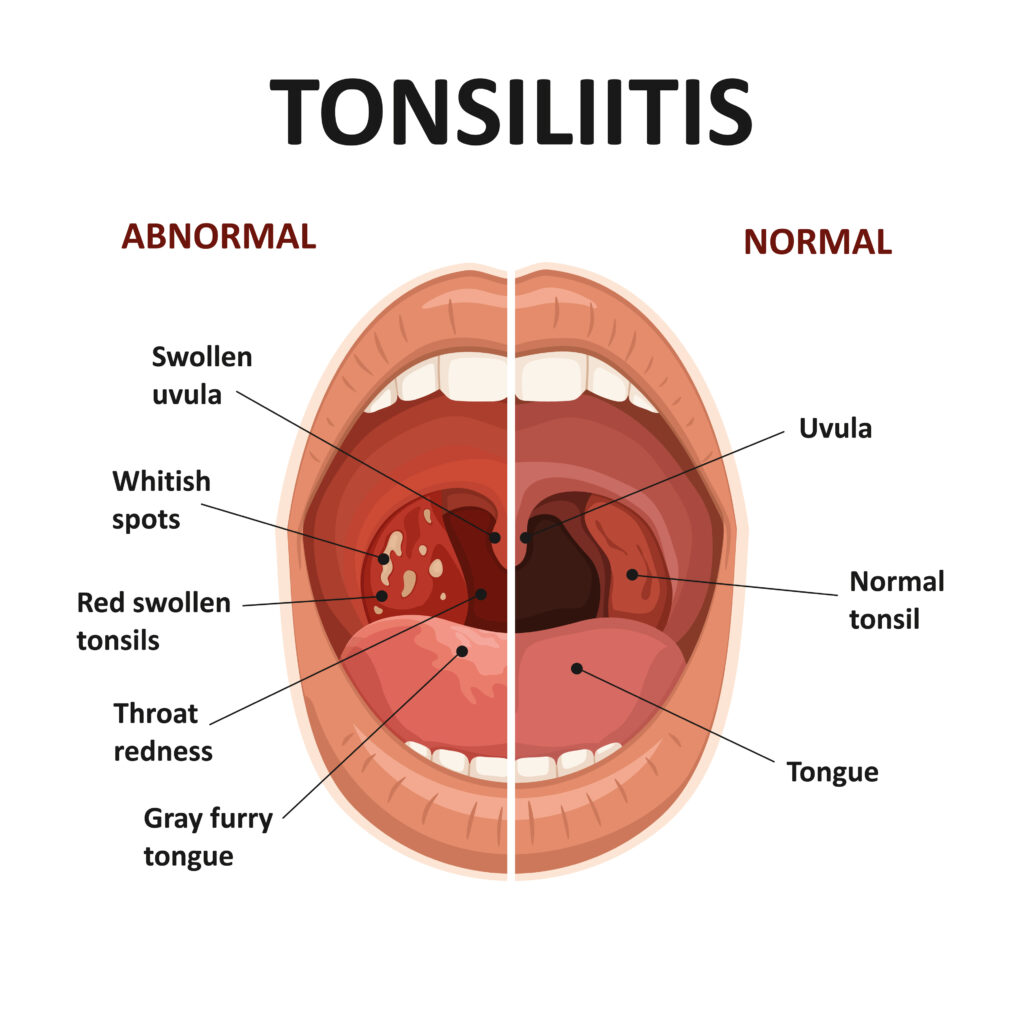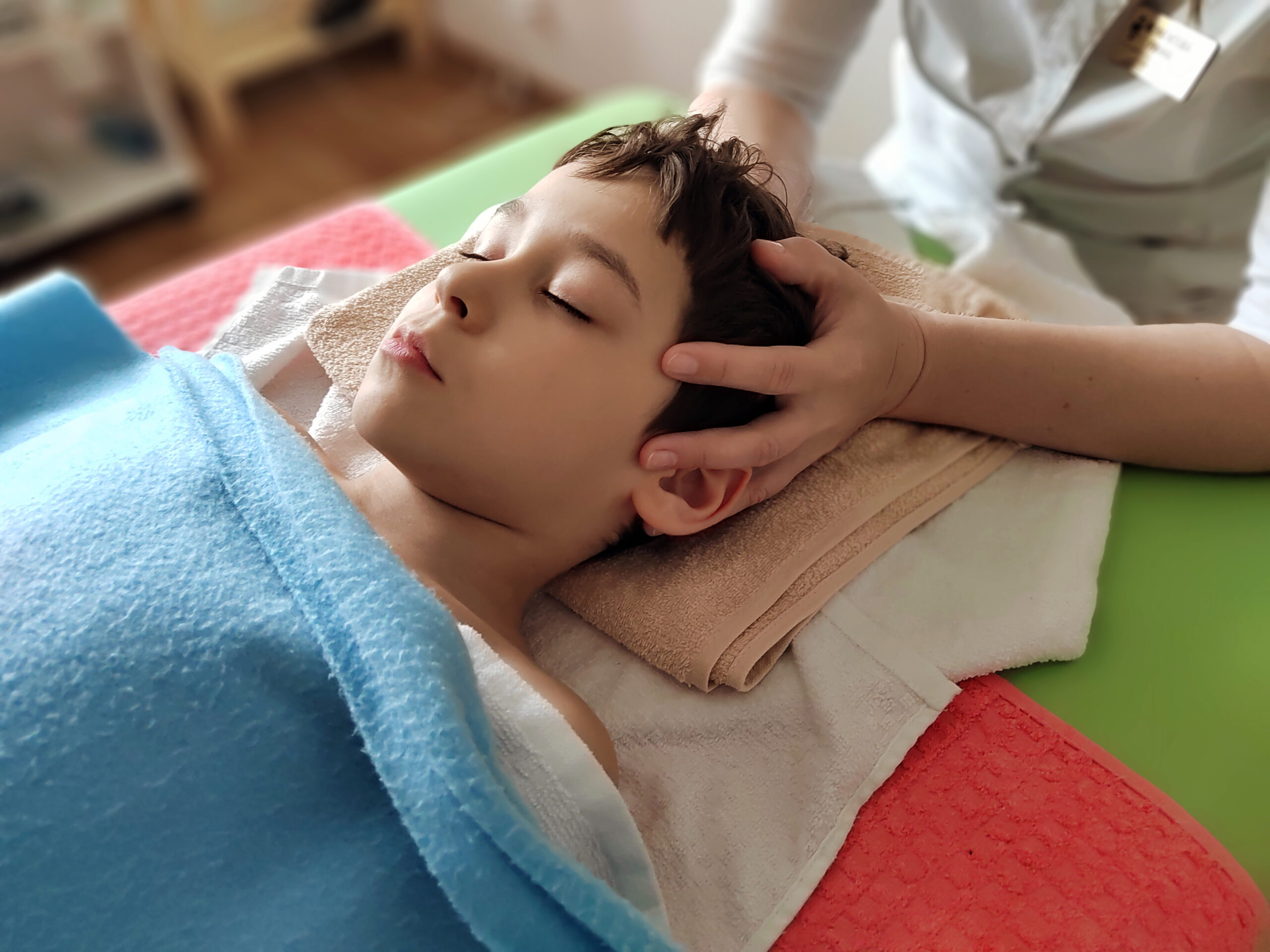Tonsillitis is a common condition that causes the tonsils in the throat to become red, swollen, and inflamed. While it can be very painful, understanding the causes, symptoms, and treatments can help you manage this condition effectively. At Heart & Soul Integrative Health, we offer holistic approaches to support your child’s recovery while knowing when traditional treatments, like antibiotics, are necessary.
What Is Tonsillitis?
Tonsillitis often involves swollen, red tonsils and can sometimes include pus-filled patches called exudates. It is frequently accompanied by fever and sore throat.
Tonsillitis can be caused by:
- Viruses
- Bacteria (commonly Group A Strep)
When strep is the cause, it may also present with a rash, often referred to as “scarlet fever.”

What are the most common symptoms of tonsillitis?
Tonsillitis typically presents with red, swollen tonsils that may have white or yellow patches called exudates. Children often experience a sore throat, fever, and difficulty swallowing. Other symptoms can include swollen lymph nodes in the neck, fatigue, and in some cases, bad breath. If caused by Group A Strep, a rash (scarlet fever) may also be present. Recognizing these symptoms early can help you take appropriate action for relief and treatment.
Symptom Relief and Holistic Treatment Options
For symptom relief and natural treatment, consider these remedies:
- Saltwater Gargle
- If your child is old enough, gargling with warm salt water can soothe throat pain and reduce inflammation.
- Congaplex by Standard Process
- Chewable capsules that provide immune support. Give 2–3 capsules, up to 4 times per day, until symptoms improve.
- Sesame Oil or Coconut Oil
- Both oils can help pull bacteria from the tonsils. Give a spoonful 2–3 times daily until symptoms improve.
- Apis Belladonna by Uriel Pharmacy
- Alleviates fever and pain. For children aged 2–11, give 5 pellets under the tongue every 1–2 hours as needed. For children aged 12 and older, give 10 pellets.
When Is Antibiotic Treatment Necessary?
If tonsillitis is caused by strep throat (confirmed by a simple throat swab), antibiotics will likely be recommended. This is essential for:
- Reducing symptom severity and duration.
- Preventing the spread of the illness.
- Avoiding complications like sinus infections, heart problems, and kidney disease.
Precaution: Children with strep throat should minimize contact with others until they’ve been on antibiotics for at least 24 hours. Also, replace their toothbrush after 24 hours to avoid re-infection.
How can I tell if tonsillitis is caused by strep throat?
While both viral and bacterial tonsillitis share similar symptoms, strep throat (caused by Group A Streptococcus) is more likely to cause a fever, swollen lymph nodes, and the presence of exudates on the tonsils. A simple throat swab performed by your healthcare provider is the most accurate way to determine if strep is the cause. If left untreated, strep throat can lead to serious complications, making timely diagnosis essential.
Are antibiotics always necessary for tonsillitis?
Antibiotics are recommended when tonsillitis is caused by strep throat to prevent serious complications like sinus infections, heart problems, and kidney disease. They also help reduce symptom severity, shorten the illness’s duration, and minimize contagiousness. However, if tonsillitis is viral, antibiotics will not be effective, and supportive care is the best course of action. Your healthcare provider can determine the appropriate treatment based on a throat swab test.
How long is strep throat contagious?
Strep throat is highly contagious, especially in the first few days. Once your child starts antibiotics, they will no longer be contagious after 24 hours. It’s important to keep them home from school or daycare during this period to prevent spreading the infection to others. Replacing their toothbrush after 24 hours of starting antibiotics can also help prevent re-infection.
When should I replace my child’s toothbrush after tonsillitis?
If tonsillitis is caused by strep throat, bacteria can linger on your child’s toothbrush and potentially cause re-infection. To avoid this, replace their toothbrush 24 hours after starting antibiotics. This simple step is an easy way to ensure a fresh start and continued recovery.
When Tonsillitis Requires Urgent Medical Attention
Seek immediate care if your child experiences:
- Drooling or an inability to swallow saliva.
- Difficulty opening their mouth wide (trismus).
- Muffled voice due to swollen tonsils.
- Severe neck pain preventing head movement.
- Pain so severe they cannot drink fluids.
- Labored breathing.
Supporting Your Child Through Tonsillitis
At Heart & Soul Integrative Health, we take a thoughtful approach to tonsillitis, combining the best of traditional and holistic care. Our goal is to provide your child with relief and recovery through natural remedies whenever possible, while also offering clear, compassionate guidance for situations where antibiotics or other interventions may be the best course of action. With Heart & Soul, you’ll feel supported every step of the way in making informed decisions for your child’s health.
GET IN TOUCH
Ready to Take the Next Step?
Schedule a consultation with our caring team to explore how we can support your family with personalized, holistic pediatric care.
Frequently Asked Questions About Tonsillitis
Red, swollen tonsils, fever, sore throat, and sometimes pus-filled patches on the tonsils.
A throat swab performed by a healthcare provider can confirm if strep throat is the cause. Additional signs include a rash (scarlet fever) and severe sore throat.
Saltwater gargles, sesame or coconut oil, Congaplex chewables, and Apis Belladonna pellets can help alleviate symptoms naturally.
Antibiotics are necessary if strep throat is the confirmed cause, as it prevents complications and reduces contagiousness.
Children are no longer contagious 24 hours after starting antibiotics.
Replace their toothbrush after 24 hours of starting antibiotics to prevent re-infection.
Difficulty swallowing saliva, severe neck pain, labored breathing, or a muffled voice are all signs that require immediate care.
Heart & Soul Integrative Health provides holistic pediatric care in Marble Falls and Burnet, serving families from across the Texas Hill Country, including Johnson City, Blanco, Kingsland, Llano, Spicewood, Lakeway, Bee Cave, and Austin. Telehealth appointments are available for some concerns. Our integrative approach combines conventional medicine with evidence-based therapies to support your child’s health and well-being.



